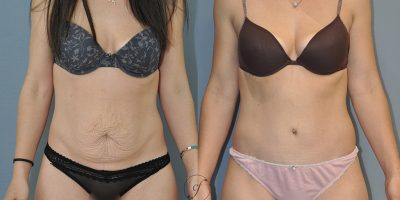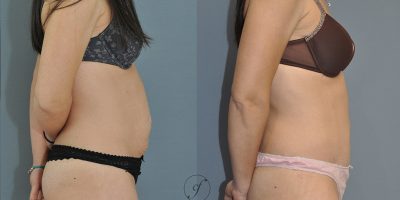One of the most frequent complaints in the postoperative period of an abdominoplasty is having to carry aspiration drains connected to the abdomen for 7 days. Not only is it uncomfortable because you have to carry the bottles everywhere, but also the drain exit holes become irritated and can become superinfected. For this reason, we decided to add a refinement to our surgical technique called “progressive tension points” (also called “quilting sutures” in English) in order to avoid this ordeal for our patients.
Progressive tension sutures consist of resorbable stitches that we apply from the detached dermal plane to the muscular plane. Generally we give around 30 resorbable stitches, which lengthens the surgery by around 30 to 45 minutes. Once the entire abdomen is sutured, we can either leave “witness” drains that indicate if there is bleeding in the first postoperative hours, or not leave drains even on the first day. There are no clinically significant differences between one option and the other and the decision is made by each surgeon and adapted to each case.
Why is seroma avoided with progressive tension points?
Seroma occurs for three reasons:
• Hematoma: If there is hematoma, the accumulated blood becomes serohematic fluid. Placing drains does not prevent the appearance of hematomas, at most it allows us to diagnose them sooner.
• Alteration of lymphatic drainage: Lymphatic drainage is altered by the scar and detachment. To minimize the alteration, the essential thing is to respect the scarpa fascia (a fascia of connective tissue that separates fat from the abdomen in two).
• Shear: The main cause of seroma is the shear that occurs between the superficial plane and the deep plane. The points of progressive tension obliterate the space and prevent shearing, making seromas very difficult.
Why don’t suction drains prevent seroma?
On the one hand, drains do not prevent hematoma, they only serve to warn us that a vessel is bleeding before it is clinically evident. On the other hand, seroma due to shear and altered lymphatic drainage occurs between postoperative day 10 and 20. It makes no sense to leave the drains in place for 3 weeks, in addition to the risk of superinfection that entails.
Scientific studies:
Below we show you the most recent scientific study on the prevention of seromas:
Quilting Sutures, Scarpa Fascia Preservation, and Meta-Analyses of Seroma Rates after AbdominoplastyPlast Reconstr Surg Glob Open. 2017 Jul; 5(7): e1429.
https://www.ncbi.nlm.nih.gov/pmc/articles/PMC5548587/
Conclusion
We can avoid the use of aspiration drains in abdominoplasty if we give progressive tension points that obliterate the space left between the detached supercial plane and the deep plane. The intervention lasts 30 to 45 minutes, but in return the postoperative period is much less painful and annoying.




